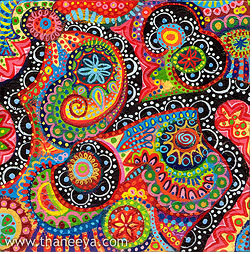Understanding Abstract Art
Understanding abstract art is easy: all it requires is an open mind and a big imagination. When you look at the painting on the left, what do you see?
Swirling shapes, an array of colorful patterns... The path of a flowing river cutting through fields of lush vegetation... or maybe you see pure energy and cosmic flow?
There is no right or wrong answer to this question. Abstract art is open to interpretation, and that is one of the beautiful things about it. Abstract art doesn't jump out and declare "THIS is what I'm all about." Instead, abstract art requires you to have an open, inquiring mind; you must enter the painting and see where it takes you. Abstract art gives you the freedom to explore the artwork and assign your own meaning to the piece. This intensely personal process enriches a viewer's experience of an artwork.
Understanding abstract art does not come naturally for everyone. It is the kind of art that makes some people scratch their heads and say, "My 5-year old could do that." What people don't realize is that the best abstract artists have excellent drawing skills, a finely honed sense of composition, and a deep understanding of the workings of color. Most abstract artists have the ability to draw a perfectly rendered rose or a realistic portrait, but they choose not to. Instead they choose to express their creativity by creating a visual experience that is more free and unencumbered by the weight of objects.
Abstract art can also make people uneasy because they don't automatically know what the art is "about" just by a cursory glance. Or they assume that because it doesn't look like anything, then it is not "about" anything. Abstract art doesn't contain recognizeable objects, so there is nothing to grasp or hold onto. This can be very confusing, even threatening, to some who are not used to assigning their own meaning to what they see before them.
The truth is, abstract art is not "about nothing". At its basis, it is about form, color, line, texture, pattern, composition and process. These are the formal qualities of artwork, because they describe what the art looks like and how it is created. Abstract art is an exploration of these formal qualities. Meaning is derived from how these formal qualities are used to create a visual (and/or visceral, cerebral, emotional, etc) experience.
How do you begin understanding abstract art?
““Everyone wants to understand art. Why not try to understand the song of a bird? …people who try to explain pictures are usually barking up the wrong tree.””
Picasso has a point. Art can't be explained adequately in words, because it's influence on people is so personal and speaks to the nonverbal parts of our existence. Therefore, art is an experience. You must let go of your need to put things into words, and let the artwork take you somewhere... even lift you into higher spheres.
You have to 'understand' abstract art with a different part of you, one that you may not normally use or be familiar with. Essentially, you must:
Accept that it is what it is. Don't try to pinpoint an exact meaning for an image.
Look at abstract art in the same way that you would listen to a symphony. When you listen to music, you don't try to hold on to the notes - you let them wash over you. Let your eyes wander over the painting the way the notes of a symphony wash over your soul. Let your eyes play with the painting, slipping around corners, following the twirls, twists and turns, dipping in and out of the surface. Let your eyes dance around the piece.
Rather than trying to figure out what the painting looks like, just allow yourself to be taken in by the painting. See what emotions, sensations or memories emerge. Let your eyes relax and travel around the piece without expectation. Examine the colors, forms, materials, surface, and how they interact with each other. Take your time. Let the painting "speak" to you.
Notice how the various elements like shape, color and form affect you. An intricately detailed, vibrant painting will affect you differently than a calm, cool Malevich.
Take a look at the two artworks below. What are the differences in how they make you feel?
Black Square
Kasimir Malevich
It is best to see abstract art in person to truly get the full effect. This will help you immeasurably with understanding abstract art. You can't get the full impact of a piece of art from a small photo in a book or pixelated image online. In person, you can see up close the texture, size, stroke of the paintbrush, shine or matte of the surface. You can feel the strength of the painting from across the room. You can stand in the space the artist once occupied, and try to imagine his or her thoughts upon each stroke of the brush.
Understanding abstract art requires an inventiveness that invites you to discover for yourself the meaning behind the work. It is not easy to grasp, like still lifes, portraits, or other form of representational art, because it is open to interpretation in a way that representational art is not.
To read more about understanding abstract art, mosey along to Understanding Abstract Art, part 2.
Click to return to the Abstract Art Table of Contents, where you can...
Abstract Coloring Video
You can also watch as I color in the luminescent abstract mandala below:
If you enjoy my videos, be sure to subscribe to my channel so that you never miss a thing! 😍
If you like my abstract art, check out my printable Abstract Coloring Book with 20 pages of intricate abstract line art to fill in with COLOR! 😍











